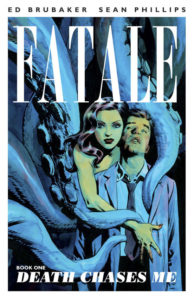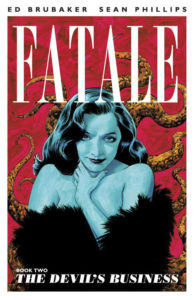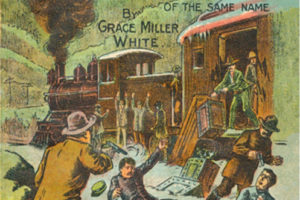 A different pulp-inspired comic from the team of Ed Brubaker and Sean Philips is Fatale. It followed their interesting Incognito series, which was inspired by pulp heroes.
A different pulp-inspired comic from the team of Ed Brubaker and Sean Philips is Fatale. It followed their interesting Incognito series, which was inspired by pulp heroes.
Fatale is inspired by a mix of crime noir and Lovecraftian horror. And like Incognito, we get a series of essays in several issues from Jess Nevins and others. The series ran 24 issues (originally planned as 12) from 2012-14.
The story concerns a mysterious femme fatale named Joséphine. She seems long lived and never ages, with flashbacks at different parts of her life going back to the ’30s, with the main storyline set in modern times. Jo is being pursued by a dangerous cult that wants to sacrifice her to their Lovecraftian gods. And the leader has very real and sinister powers.
Jo has an effect on men, something she can’t always control, that compels them to help her — as a lover, guardian, or the like. And it usually doesn’t work out well for the men in question.
We meet her in the first issue, at the funeral of author Dominic Raines, who had come under her influence. She meets his godson, Nicholas Lash, who is pulled into her world.
The first five issues comprise the first book, “Death Chases Me.” In the modern time, Nicholas tries to figure out things, after loosing one of his legs in an encounter between Jo and the cultists after her. He finds an early unpublished book by Raines. The rest of the issues is a flashback to 1950s San Francisco, were Jo is under the protection of a crooked cop who found her in WWII. The cultists, lead by The Bishop, who is not wholly human, are again closing in. She encounters a young Dominic Raines, who becomes involved with Jo.
The next five issues make up the next book, “The Devil’s Business.” Again, in modern times, Nicholas is still trying to figure things out, and getting pulled further and further into Jo’s world. The unpublished manuscript gets stolen, and he goes after it. He is accused of killing the thief, which he didn’t do, and is jailed. Only to find that the manuscript was published. The flashback in this book is to 1970s Hollywood where Jo is hiding out, but the cultists are still after her. They find her home, but she’s able to escape.
The next four issues actually are a set of stand-alone stories and comprise the third book, “West of Hell.” Two tell of forerunners of Jo. Issue #11 is a story of Jo set in 1936 Texas, and her encounter with a pulp writer who has had his own encounters with the cult after Jo. He seems a kind of cross between H.P. Lovecraft and Robert E. Howard. Issue #12 is about Mathilda, an 13th century version of Joséphine.
 Issue #13 is about “Black” Bonnie in 1880s Colorado, yet another in what appear to be a line of similar women. She would evade the cult in the old West, but they would sacrifice her in 1906 San Francisco, which was the cause of the earthquake, and the birth of The Bishop. Issue #14 is about Jo in 1943 Romania, where she is rescued from the cult by Walter Booker. We also find out how Jo was able to gain what knowledge she does of the occult and use it to protect herself.
Issue #13 is about “Black” Bonnie in 1880s Colorado, yet another in what appear to be a line of similar women. She would evade the cult in the old West, but they would sacrifice her in 1906 San Francisco, which was the cause of the earthquake, and the birth of The Bishop. Issue #14 is about Jo in 1943 Romania, where she is rescued from the cult by Walter Booker. We also find out how Jo was able to gain what knowledge she does of the occult and use it to protect herself.
“Pray for Rain” is the next book, composed of the next five issues. We pick back up with Nicholas still in jail awaiting trial. But a guy who claims to be from Jo breaks him out, killing several doing so. This book’s flashback is to 1990s Seattle. Jo has run afoul of a serial killer obsessed with Jo since encountering her as a child. Injured, she stumbles into a rock band living in a house outside of Seattle. So she has the serial killer and the cult after her, while not fully aware of who she is and vulnerable. And we find out that the guy who breaks out Nicholas is actually the one survivor from the band after the serial killer found it looking for Jo.
Things come to a head in the final five issues that comprise the last book, “Curse the Demon.” There is no long flashback this time, though we get some glimpses in the past of some characters: Jo’s first attempts at committing suicide (she can only be killed in the rituals of the cult), glimpses of the past of The Bishop going back to 1906 San Francisco, Jo meeting The Librarian, a collector of occult knowledge, and the like. Things finally come to a head with the cult. Jo defeats them (finally?), and is able to grow old and maybe die normally, but it comes at a great cost.
As I noted, many issues had articles by Jess Nevins and other. These go into a variety of topics in pulp, crime and related topics. The articles are:
- “H.P. Lovecraft and the Horror of the Unseen” (#1)
- “Edgar Allan Poe” (#2)
- “Dan J. Marlowe” by Charles Kelly (#3)
- “The Real Philip Marlowe” by Stephen Blackmoore (#4)
- “Horror and Mystery Fiction, Part 1: Otranto to de Grandin” (#6)
- “Horror and Mystery Fiction, Part 2: Weird Menace Pulps” (#7)
- “The Devil Inside Me: Devil Pulp” (#10)
- “The Lonely Doll” by Megan Abbott (#12)
- “Strange Stories” by Jack Pendarvis (#13)
- “Aleister Crowley” (#15)
- “Cthulhu Lives: On the Afterlife of HPL” (#18)
- “Cults in Fiction” (#21)
- “Leaping the Fence: Fallen Heroes and Redeemed Villains” (#24)
The series is available in five paperback collections, but they don’t include any of the essays from the comics (same as with Incognito). There are two deluxe editions which collect the first 10 issues and the last 14, but only a few of the essays are included. The first two articles (HPL & Poe) were included in the first deluxe edition. No idea which ones were included in the second.
This is an interesting blend of crime and horror. If you can accept the idea of cosmic horror in a crime novel setting, you will probably enjoy this series. The articles are an added bonus, I just wish they had been included in the collections. Please be aware that this is an adult series, with a level of blood and gore, along with sex and nudity, that is a higher than in most mainstream titles.



